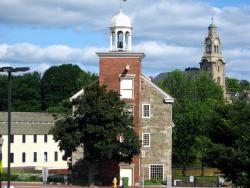Referred to as the "catalyst of the Industrial Revolution," textile manufacturing helped to transform the American economy from an agricultural to a manufacturing economy. It led to transitions from human to mechanical power and from wood to metal construction. Population shifts resulted from significant numbers of people moving from rural areas to work in urban factories. The collection of tools and machinery housed at the American Textile History Museum (ATHM) represents a collection of ideas which developed during this period.
Textile

The Wilkinson Mill, situated on the west bank of the Blackstone River in Pawtucket, was built between 1810 and 1811 by machinist Oziel Wilkinson. Constructed in stone rubble, three and one-half stories high, the mill played a critical role in the history of textile technology, in steam power generation, and in the development of the machine tools industry. The Wilkinson family came to Pawtucket in the 1780s and set up a shop to forge anchors, build presses for oil works, and mold iron screws used in paper pressing machinery.
Innovations

The Wilkinson Mill, situated on the west bank of the Blackstone River in Pawtucket, was built between 1810 and 1811 by machinist Oziel Wilkinson. Constructed in stone rubble, three and one-half stories high, the mill played a critical role in the history of textile technology, in steam power…
Read MoreReferred to as the "catalyst of the Industrial Revolution," textile manufacturing helped to transform the American economy from an agricultural to a manufacturing economy. It led to transitions from human to mechanical power and from wood to metal construction. Population shifts resulted from…
Read More

